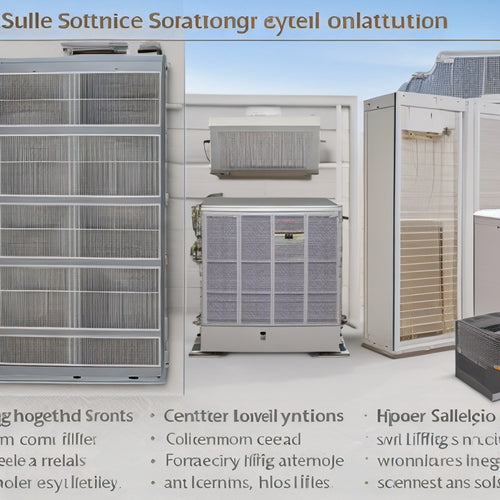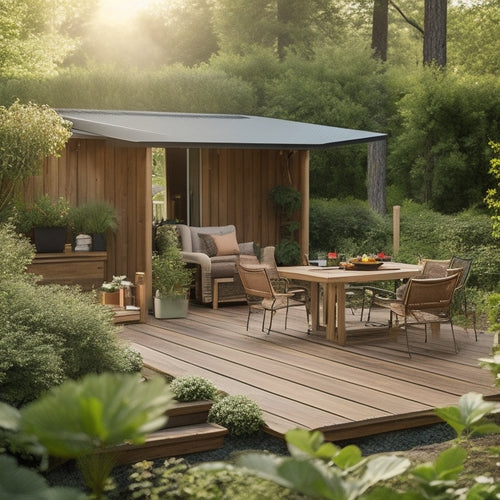
Why Natural Ventilation Boosts Greenhouse Efficiency
Share
By incorporating natural ventilation into your greenhouse design, you can reduce energy consumption by up to 30%, leading to significant cost savings and a lower carbon footprint. This approach promotes a healthier growing environment, enhances control over light exposure, humidity, and temperature, and supports sustainable agricultural practices. Fresh air circulation is essential for reducing CO2 levels, promoting plant health, and ensuring consistent airflow. By optimizing natural ventilation, you'll not only enhance crop yields but also minimize your environmental impact. Now, explore how to access the full potential of natural ventilation in your greenhouse operation.
Key Takeaways
- Natural ventilation reduces energy consumption by up to 30%, leading to significant cost savings and a lower carbon footprint.
- It creates a healthier environment for crops by enhancing control over light exposure, humidity, and temperature, promoting stronger plants and disease resistance.
- Natural ventilation strategies improve air quality, contributing to stronger plants, enhanced disease resistance, and effective nutrient absorption.
- By reducing energy costs, natural ventilation leads to lower operating expenses, predictable budgets, and extended equipment lifespan.
- Optimizing greenhouse design with natural ventilation integration stimulates healthy plant growth, maximizes yields, and minimizes environmental footprint.
Harnessing Nature's Cooling Power
Through clever design and strategic placement, you can capitalize on natural ventilation to employ nature's cooling power, greatly reducing the need for mechanical cooling systems in your greenhouse.
By understanding thermal interactions, you can enhance airflow patterns to maximize heat exchange between the interior and exterior. As the transportation sector shifts towards sustainable energy sources, such as Renewable Energy Sources for EV Charging, it's crucial to investigate alternative methods for maintaining ideal temperatures.
This is achieved by carefully positioning vents, windows, and shading devices to facilitate a smooth flow of air. As air enters the greenhouse, it absorbs heat, and then exits, carrying excess heat away.
Reducing Energy Consumption Costs
You can considerably reduce your energy consumption costs by identifying energy savings opportunities in your greenhouse's ventilation system.
By optimizing natural ventilation strategies, you'll lower your operating expenditure and allocate resources more efficiently.
Implementing time-of-use rate strategies cost-effective charging and managing peak demand can also lead to substantial savings.
This, in turn, will lead to increased profitability and a more sustainable growing operation.
Energy Savings Opportunities
As greenhouse operators strive to optimize their facilities, reducing energy consumption costs becomes a critical aspect of maintaining profitability.
You can capitalize on energy savings opportunities by adopting sustainable practices, such as natural ventilation, which reduces the need for mechanical cooling systems.
By incorporating hybrid electric solutions, improving fuel efficiency and reducing emissions, you can further minimize energy consumption.
A well-designed ventilation system, considering factors like building orientation and airflow optimization, can minimize energy consumption.
Conduct a cost analysis to identify areas of improvement and implement seasonal strategies that adapt to climate changes.
By incorporating passive cooling techniques and ensuring regulatory compliance, you can minimize your energy management costs.
Lower Operating Expenditure
Optimization of energy consumption is essential to minimizing operating expenditures in greenhouse operations.
As you implement natural ventilation, you'll notice a significant reduction in energy costs. By leveraging natural air circulation, you can decrease your reliance on mechanical ventilation systems, which guzzle energy.
This, in turn, leads to:
- Lower electricity bills, resulting from reduced energy consumption
- Simplified cost analysis, as your energy expenses become more predictable
- More effective budget planning, allowing you to allocate resources to other areas of your operation
- Decreased grid dependence, which mitigates risks of power outages, ensuring continuous operations
- Improved environmental sustainability, as natural ventilation reduces the strain on traditional power plants, conserving water resources and minimizing air pollutants.
Improving Air Quality Inside
You can greatly improve air quality inside your greenhouse by ensuring fresh air circulation, which helps to reduce CO2 levels and promotes healthier plant growth.
By introducing natural ventilation strategies, you can create an ideal indoor environment that supports plant development and reduces the risk of disease.
Additionally, embracing renewables in fleet operations can lead to considerable savings on fuel costs Economic Benefits of Renewable Energy Adoption, which can be invested in enhancing greenhouse efficiency.
Fresh Air Circulation
Fresh air circulation is the backbone of a healthy and productive greenhouse environment, and it's essential to get it right. You need to guarantee that your greenhouse has a consistent flow of fresh air to remove stale air, excess heat, and humidity.
This is where natural ventilation strategies come into play. By understanding airflow mechanics, you can design a ventilation system that promotes healthy air circulation.
Some key considerations for ideal fresh air circulation include:
- Minimizing air resistance through careful placement of vents and fans
- Maximizing air exchange rates through strategic vent sizing and placement
- Creating a pressure gradient to drive air flow through the greenhouse
Reduced CO2 Levels
With a consistent flow of fresh air in place, attention turns to reducing CO2 levels inside the greenhouse, a significant aspect of improving air quality.
You'll find that natural ventilation plays a major role in carbon capture, removing excess CO2 that can hinder plant growth. By allowing fresh air to circulate, you're restoring atmospheric balance, which is essential for maintaining a healthy environment.
This, in turn, enables you to create an ideal growing space where plants can thrive. By reducing CO2 levels, you're not only improving air quality but also promoting a more sustainable growing practice.
With natural ventilation, you're taking an important step towards creating a balanced and thriving ecosystem within your greenhouse.
Healthier Plant Growth
During peak growing seasons, natural ventilation proves instrumental in promoting healthier plant growth by improving air quality inside the greenhouse.
By allowing fresh air to circulate, you create an environment that encourages ideal plant health. This, in turn, enhances nutrient absorption, disease resistance, and growth rates.
Some key benefits of natural ventilation on plant health include:
- Improved root development through consistent moisture levels
- Enhanced light exposure, which increases photosynthesis and overall growth
- Effective pest management, reducing the need for chemical interventions
Boosting Crop Yields Naturally
By incorporating natural ventilation strategies into greenhouse design, growers can create an ideal environment that stimulates healthy plant growth and enhances crop yields.
You'll be able to adopt sustainable practices, like crop rotation and organic methods, which promote soil health and biodiversity.
Natural ventilation also enables climate adaptation, reducing the need for artificial climate control. This, in turn, allows for more precise nutrient optimization and variety selection, customized to your specific growing conditions.
By integrating these strategies, you'll be able to plan your seasons more effectively, minimizing the need for pest management and maximizing your yields.
Minimizing Environmental Footprint
Nearly 75% of greenhouse gas emissions in horticulture come from energy consumption, making it a significant environmental concern.
By incorporating natural ventilation into your greenhouse design, you can reduce your reliance on energy-intensive climate control systems and minimize your ecological impact. This shift towards sustainable practices not only benefits the environment, but also helps you save on energy costs.
Some key ways natural ventilation can help you reduce your environmental footprint include:
- Decreasing energy consumption by up to 30%
- Reducing your carbon footprint and contributing less to climate change
- Creating a healthier, more natural growing environment for your crops
Creating Optimal Growing Conditions
As you reduce your reliance on energy-intensive climate control systems through natural ventilation, you're also creating an opportunity to fine-tune your greenhouse's internal environment.
You'll have more control over light exposure, humidity control, and temperature regulation, allowing you to optimize conditions for your crops.
By monitoring soil moisture and nutrient distribution, you can verify your plants receive exactly what they need.
Implementing crop rotation and pest management strategies will further promote healthy growth.
By selecting plants suited to your local climate and adapting to seasonal changes, you'll be able to synchronize your growth cycles with nature.
This precision will ultimately lead to increased yields and a more sustainable operation.
Increased Ventilation Efficiency
Optimize your greenhouse's ventilation system by strategically placing vents and windows to capitalize on natural airflow. By doing so, you'll create an efficient ventilation design that utilizes the power of airflow movements.
This approach allows you to:
-
Maximize air exchange rates, reducing the risk of overheating and promoting a healthy growing environment
-
Minimize the need for mechanical ventilation systems, reducing energy consumption and costs
-
Create a more consistent and predictable airflow pattern, ensuring uniform temperature and humidity distribution throughout the greenhouse
Lowering Operating Expenses Long-Term
By incorporating natural ventilation strategies into your greenhouse design, you can markedly reduce operating expenses in the long term. This is because natural ventilation eliminates the need for mechanical ventilation systems, which can be costly to install, operate, and maintain. By leveraging sustainable practices, you can create a more efficient and cost-effective greenhouse operation.
| Savings Area | Cost Savings | Payback Period |
|---|---|---|
| Reduced energy consumption | 20-30% | 2-3 years |
| Lower maintenance costs | 15-20% | 1-2 years |
| Extended equipment lifespan | 10-15% | 3-5 years |
| Reduced water consumption | 5-10% | 1-2 years |
Frequently Asked Questions
Can Natural Ventilation Be Used in Greenhouses With Limited Roof Space?
When you're stuck in a small elevator, you crave clean air, right? Similarly, in greenhouses with limited roof space, you can still utilize natural ventilation by employing limited roof strategies and airflow optimization, ensuring a gust of clean air for your crops to thrive.
How Does Natural Ventilation Affect Greenhouse Temperature at Night?
You'll find that natural ventilation greatly impacts greenhouse temperature at night, allowing for effective nighttime cooling and precise temperature regulation by leveraging cooler outside air to reduce heat buildup and maintain ideal growing conditions.
Are Natural Ventilation Systems Compatible With Existing HVAC Systems?
You're probably thinking natural ventilation and HVAC systems can't coexist, but surprisingly, they can! Hybrid systems combine the two, optimizing energy efficiency and reducing costs, giving you the freedom to choose the best of both worlds.
Do Natural Ventilation Systems Require Frequent Maintenance Checks?
You'll find that natural ventilation systems don't require frequent maintenance checks, as they're designed to operate with minimal moving parts, ensuring peak system performance and reducing maintenance frequency, giving you the freedom to focus on other aspects of your greenhouse.
Can Natural Ventilation Be Used in Greenhouses With Diverse Crop Varieties?
You can design natural ventilation systems to accommodate crop diversity by implementing flexible ventilation strategies, such as adjustable vent openings, to cater to different crop requirements, ensuring ideal growing conditions for a wide range of crops.
Related Posts
-

Why Solar HVAC Filters Revolutionize Home Energy Efficiency
By adopting solar HVAC filters, you're shifting your home's energy reliance from fossil fuels to clean, renewable sou...
-

7 Solar-Safe Window Solutions for Earth-Conscious Homeowners
As an earth-conscious homeowner, you're likely keen to find solar-safe window solutions that align with your values. ...
-

Green Deck Options: Earth-Conscious Choices for Your Home
You're looking for a deck that not only enhances your home's exterior but also aligns with your eco-friendly values. ...


